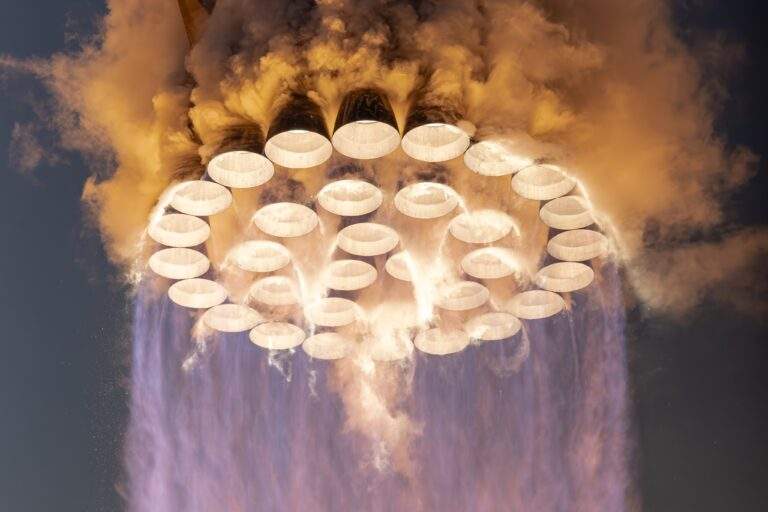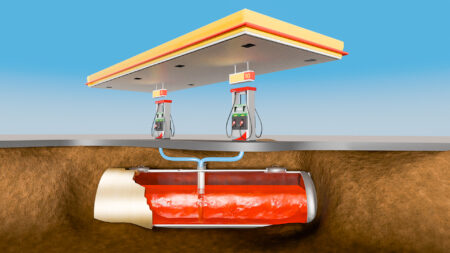SpaceX are targeting April 17 at 12:00 UTC for the inaugural launch of Starship Super Heavy. The mission is the vehicle’s first integrated flight test and aims to provide SpaceX with vital data which will be used in preparation for future launches. Now that the FAA has granted a launch license, SpaceX can now proceed towards the launch of the world’s most powerful rocket ever developed.
The Evolution of Starship
Since 2012, when the Raptor engine was first announced, development of Starship has continued at a remarkable pace.
The vehicle, now called Starship Super Heavy, has undergone various name changes since its first in 2013. This has often been the case due to major design changes. In 2013, SpaceX unveiled the Mars Colonial Transporter which the company said would be capable of carrying up to 200 tonnes to Low Earth Orbit (LEO). Whilst under this name, the material of the vehicle’s tanks changed from a lithium aluminium alloy to carbon fibre. There was also a switch from a triple core to a single core design.
Years later in 2016, the Mars Colonial Transporter became the Interplanetary Transport System which was to be a colossal 12m in diameter and capable of launching 300 tonnes to orbit.
This soon changed to what was known as the Big Falcon Rocket in 2017 with its diameter cut to 9m and when in a reusable configuration, would be able to launch a more realistic 150 tonnes to orbit.
The Big Falcon Rocket name was scrapped in 2018 with Starship being the new name. Whilst the vehicle has undergone several design changes in the last few years, perhaps the last major change came with the move to stainless steel replacing carbon fibre. The decision made was mostly down to cost.
Previous Test Flights
Whilst the land in Boca Chica was first purchased in 2014 by SpaceX, little happened there for several years. The area only started to become a hive of activity in the late 2010s.
In 2019, the much-loved Starhopper vehicle took flight for the first time at an altitude of 20m. Though only a small hop, the test was significant as marked the first firing of a Raptor engine during flight bar Starhopper’s tethered flights earlier in the year. Starhopper went on to also conduct a 150m hop.
Despite the prominent issue of COVID-19 throughout most of 2020, it proved to be an eventful year for the Starship programme with numerous anomalies but also important progress. Though SN1, SN3, and SN4 all ‘failed’ in testing, SN5 and SN6 successfully completed 150m hops later in the year creating quite the spectacle.
Once enough data had been collected from previous prototypes, SpaceX transitioned to manufacturing full Starship prototypes culminating in SN8’s ‘successful’ test flight in December 2020 despite a fiery explosion upon landing. SN9, SN10, and SN11 also met the same fate until SN15 nailed the landing in mid-2021.

Milestones Prior to Launch
As a license has now been granted, there are few milestones that must occur for a launch on April 17. Ship 24 is yet to have been restacked onto Booster 7 since the flight termination system must be armed. In addition, an evacuation notice must be sent to residents before Starship can proceed with a launch attempt.
To ensure safety for those nearby, temporary flight restrictions, a flight road closure, and a marine hazard notice are now all in place. These are released to ensure the safety of the public.
Starship Orbital Flight Test Checklist! ?
— Primal Space (@thePrimalSpace) April 14, 2023
•FAA launch license ?
•All TFRs ?
•Flight road closure ?
•Marine hazard notice ?
•Evacuation notice ?
(Credit: SpaceX) pic.twitter.com/gzS40p9SSD
Launch Day
The final countdown to launch will begin at T-2 hours where SpaceX’s flight director will give a go for propellant loading. Fuelling will then begin at T-1 hour and 39 minutes.
Providing fuelling goes smoothly, engine chill will occur at T-16 minutes and 40 seconds. This cools down the engines to condition them for launch. Raptor engine start-up will then begin at T-8 seconds.
Following lift-off, the first mission objective will be to clear the pad infrastructure. Avoiding any damage to stage zero would be an achievement for the company, preventing any further setbacks prior to the next orbital launch attempt.
If first stage flight continues nominally, Max Q should occur at around T+55 seconds. This is the point at which maximum stress is placed on the vehicle during flight and so will be an important test for Starship’s structural integrity.
Just prior to T+3 minutes, a trio of events is expected with Booster main engine cut-off, stage separation, and Ship ignition.
After stage separation, the Booster will perform both a boost back and landing burn before a water landing in the Gulf of Mexico.
After nearly a full orbit around Earth, Ship re-entry will occur at T+1 hour, 17 minutes, and 21 seconds and will splashdown in the Pacific Ocean around 13 minutes later.
This is a test flight, so it is likely that not all milestones are achieved. The aim of the flight is to gather data for future flights and to continue the development of the Starship Super Heavy system.
Featured Image Credit: SpaceX












